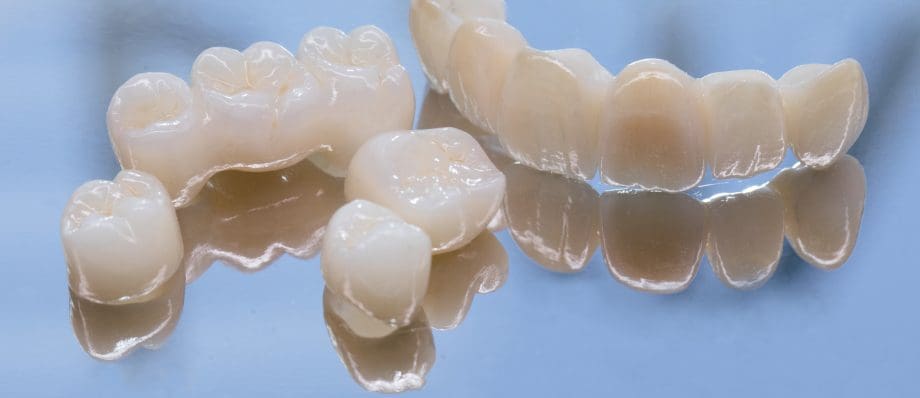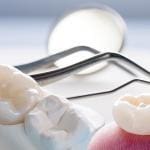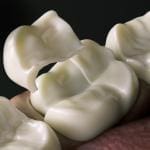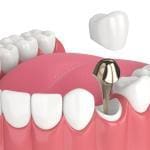A dental crown is one of the most common and practical restorative dental procedures dentists perform. Dental crown is a custom-made, permanent restoration. It looks like a hollow, tooth shaped “cap” that restores the anatomic crown of the tooth, which is placed over a prepared tooth to play a role in chewing food where is the actual crown of the tooth completely or partially damaged.
What is a Dental Crown or cap?
We use the word crown to describe the anatomical portion of each tooth that protrudes out of the gums and bone. The crown of the tooth does not include the tooth’s roots. Whereas , the other part of the tooth is the root, which is under the gum and you cannot see it. The dental crown or dental cap is placed over the prepared crown of the tooth and completely covers a tooth. In cases where Teeth have had root canal therapy, they can be fragile, considering the dentist may need to remove a comparatively greater amount of internal tooth structure, to the point where the tooth may become significantly hollowed out, and as a result, are already in a weakened state.
Since dental crowns provide a strengthening effect that can help to prevent fracture, a dental crown will frequently be recommended in root canal or endodontically treated teeth.
When do we need a dental crown?
Dental crowns can do a lot for your smile. crown may be used to provide outstanding beauty to your smile and creating a winning smile. Some people believe that this treatment is painful, it is worth mentioning that since dental crowns are mostly placed over root canal teeth, there will be no pain.
When the tooth has suffered a deep decay to an extent that it cannot be repaired only by filling, for example the crown of the tooth is broken, the tooth is endodontically treated, or sometimes just to enhance the natural beauty of the tooth, a dental crown is used.
In cases where is a tooth fracture which is a break or crack in the hard shell of the tooth or a significant amount of lost tooth structure in consequence of decay; Also, fragile teeth following root canal treatment. Since endodontic treatment generally reduces the fracture resistance of teeth, they will need to be repaired and reconstructed with tooth-shaped dental crowns.
Improper nutrition and lack of proper oral hygiene can damage tooth structure due to the decay, and trauma can also cause tooth fractures. If such damage deep enough leading to weak, brittle teeth, the remaining structure of the tooth needs to be strengthened by a dental crown.
Fixed dental prostheses, or crowns In addition to providing a strengthening effect when minimal tooth structure remains, also improve the appearance of a natural tooth. It also refers to the cases who have microdontia, a medical term for atypically small teeth or teeth that appear to be unusually smaller or disproportionate to other teeth. Some people will use the phrase “short teeth” to describe this phenomenon which is mostly linked to genetic conditions and it’s congenital.
There are different types of dental crowns. Gold crowns are very durable and strong, which is why they are used in back teeth restorations. All-porcelain crowns are the most widely used type of crowns for their natural look and metal-free composition. Porcelain-fused-to-metal are less costly.
Types of dental crown
Dental crowns are divided according to the kind of material they made from and how they are made. Here we point out the most common types of dental crowns and represent the uses and advantages and disadvantages of each one.
Full metal dental crown
First dental crown was made up of full metal such as gold. Gold crowns have been used in the dental industry for hundreds of years and are still able to provide durable and long-lasting solutions for damaged teeth. That said, gold crowns are rarely used in modern dentistry though, and is almost obsolete. As for aesthetic reasons and its unacceptable appearance.
This type of cap can only be used over the back teeth and places where is loss of vertical dimension of occlusion and crown lengthening is contraindicated. Because it has great strength in low thickness. Another case is the use of all-metal crowns in children’s dentistry under the name SSCs (Stainless Steel Crowns).
Nowadays the majority of crowns made today have metal in them as a base of the crown for strength. To get the benefits of metal’s strength and ceramic’s whiteness.
Porcelain fused to metal crowns
This type of dental crown is the most common among other types of dental crowns. Metal alloy is used as infrastructure or base to provide strength and compatibility with teeth, and ceramic is placed over the metal to achieve beauty. Regular PFM is handmade by dental technician by casting. The dental Lab technician makes a metal coping so called metal cap which is applied over a prepared tooth. It can be used to support porcelain.
A Noble metal alloy which contains precious metals is strong and highly resistant to corrosion. Then porcelain powder or ceramic is placed over the metal frame. After designing the ceramic, it is placed in the ceramic kiln for firing. The baked ceramic is glazed with ceramic glazes to make it look beautiful as well as to give it more strength.
The dentist uses a diamond burs to prep teeth for a PFM or porcelain fused to metal. After prepping the tooth, an impression is taken from the prepared tooth with special silicone material and the impression will be sent to the dental lab. In the lab, the lab technician makes a dental cast with plaster, the positive reproduction of a patient’s teeth and surrounding tissues obtained from a dental impression. Then, dental technician builds up the metal frame utilizing a wax-up technique. Technically, the entire metal core is sculpted in wax at the precise shape and size considering all aspects demanded by the particular clinical situation.
Once the molten metal alloy is cast, the whole wax pattern is converted to a replicate in dental alloy.
Porcelain fused to metal crowns (PFM crowns) are metal crowns with a layer of porcelain fused on the metal. This makes them almost as durable as pure metal crowns but a lot more esthetic. PFM crowns used to be the most popular crowns in dentistry for quite a long time.
Advantages of PFM restorations
- Appealing Visually – Aside from a small dark margin, PFM Crowns give you a natural and attractive smile.
- Strong And Durable – while PFM Crowns may lack in ideal cosmetic, they make up for in strength and durability. With the right maintenance and proper oral hygiene, they can last for many years.
- Fit Better – The metal structure of PFM crowns mean that they fit better than alternatives. Which make them a good choice to be placed over every tooth of the mouth.
- Affordable – PFM crowns are one of the cheapest types of crows available, due to the easy and affordable process of making them.
- Implant crown – they fit perfectly on dental implants. PFMs attach to implants simply by cementing the crown onto the abutment that connects to the dental implant.
Disadvantages of PFM restorations
- Dark Lines – The downside of the metal portion of this type of crown is the presence of a black margin where the tooth meets the crown. In case of gum recession, a black margin of metal can be seen specifically in front tooth or the bridge of the front tooth and make a smile unpleasant.
- Lots Of Tooth Trimming Is Required – When you opt for PFM crowns, the dentist will have to remove a considerable amount of tooth.
- Some people are allergic to alloy metal.
- It cannot be made completely with CadCam.
Uses of PFM restorations
- Single tooth crown
- Short-span and long-span dental bridges
- Implant crown
- Partial denture anchor base
- Restoring teeth with root decay.
- patient with Teeth grinding (bruxism)
Full Porcelain Crown
Porcelain crown is the first generation of dental crowns in cosmetic dentistry. In 1903, Dr. Charles Land introduced the all-porcelain jacket crown – an invention he patented in 1889 that is the first modern rendition of the dental crown we know today. An all-ceramic crown is usually made entirely from dental porcelain or another type of ceramic. As with all others types of dental crowns, the crown sits over a filed-down tooth to restore its appearance.
Zirconia ceramic is a new type of high-tech ceramic, these Restorations are made from the highest quality porcelain and made of CAD CAM. The burnout oven and casting machine have been replaced by model scanning and CAD/CAM milling machines.
CAD CAM involves the manipulation of a 3-D design on the computer screen, followed by the automated production by a computer-controlled milling machine.There are three components to the CAD/CAM system: scanning, designing, and milling. All are usually housed at the laboratory.
Advantages of all-Porcelain crowns
- porcelain crown looks like a real tooth yet is highly durable too and will be improving your smile
- not only doesn’t cause sensitivity but sometimes, porcelain crowns can also reduce the patient’s dental sensitivity.
Disadvantages of all-Porcelain crowns
- They are less strong and durable than their metal and porcelain-fused-to-metal counterparts.
- all-porcelain crowns are usually more susceptible to chipping or breaking because of their fragility.
- For porcelain crowns, to gain more strength, it is required that the tooth be ground down more than with other options.
- Better be used for front teeth.
- It is only suitable for single teeth and is not applicable for dental bridges.
- Not suitable for dental implants.
- It shows the discoloration of the teeth underneath.
Uses of All-Porcelain Crowns
- single anterior tooth crown
- Porcelain laminate veneer
- Onlay and inlay
Porcelain Fused to Zirconia Crowns
This type of dental crown is also called zirconia crown. as mentioned above, all- ceramic crown is weak in tension and has poor shock resistance whereas basically improves the appearance of the tooth. This crown has become one of the favorite choice for both dentists and their patients. The reason for this preference is because this type of crown combines strength, durability and aesthetics. Porcelain fused to zirconia crowns are formed by porcelain being combined with zirconium oxide. The zirconia base has a matte white shade and is layered with porcelain to match final restoration. The porcelain fused with zirconia crowns are designed and milled using computer aided design or computer aided manufacturing technology.
Since Zirconium is naturally biocompatible, does not produce any chemical reaction in the mouth which is an important factor since some reactions would damage the crown or cause allergic reactions in the long run.
Advantages of Porcelain Fused to Zirconia Veneers
- Superior looks: since zirconia is naturally white, it allows the transformations to any shade which match with your other teeth.
- Extraordinarily tough:zirconia crown is the strongest, it can withstand wear and tear.
They bond well with your tooth: zirconia crowns adhere well to your tooth. Zirconia has this property that bonds well with the tooth and holds the crown in place.
- 100% biocompatible:no zirconia crown allergy has been reported so far. The fact that there is no need to worry about any adverse allergic reactions from your periodontium or gums because it is not rejected by the human body.
- Metal free: many people don’t like having metals in their body. Zirconia is most suited for them.
Disadvantages of Porcelain Fused to Zirconia Crowns
- Amount of tooth structure removal in preparation of theses type of crown is higher than that of PFM crown. To have the optimal strength, the zirconia base needs to have the necessary thickness.
- In areas where the frame becomes thin, it is prone to breaking
- It is not recommended to be used in long-span dental bridges as may not stand the pressure of chewing and bite force.
- It may show the dark shadow of the teeth beneath. For this reason, zirconia crowns better not be placed over the amalgam filling and it is better to replace the amalgam with dental composite first.
- The material’s toughness has raised some concerns about friction against the tooth root and wearing down opposing teeth.
- It is more expensive than PFM crowns
Uses of Porcelain Fused to Zirconia crowns
- single tooth
- Short-span dental bridge
- Onlay and inlay
- Cases in which a person is allergic to metal
Full Zirconia Crown
Zirconium is a relatively new material that combines the strength of metal with the aesthetics of porcelain crowns. As already stated, the solid zirconia is opaque, so it’s generally recommended for improving the aesthetics and transparency, ceramic needs to be placed on the base of Zirconia. New High-Translucent Zirconia, brought the technology of aesthetic dentistry to the next level. This means that this type of zirconia, in addition to strength and durability, provides excellent aesthetic and transparency like ceramic. It’s worth mentioning that Zirconia is even more durable than the PFM ceramics that are commonly utilized. Solid zirconia, for instance, has more stabilizers than porcelain fused to metal crown, making it more resistant to chewing and grinding forces.
A higher technology is needed to make this type of dental crown. Full Contoured Zirconia Crowns are CAD/CAM milled zirconia restorations. Meaning that the computer file of the 3D scan is sent to the digital dental laboratory via the Internet which is stained glazed for natural anatomy effects with no layered ceramic. Thanks to newer monolithic zirconia (single, solid blocks of zirconia), this crown is nearly unbreakable and built to withstand the harsh environment the posterior of the mouth endures better than all-porcelain crowns.
Zirconia has improved significantly by introducing a more comprehensive array, allowing for more significant shade variation and translucencies that closely resemble natural dentition.
Advantages of Full Zirconia Veneers
They are as natural as it gets and blends in well with the rest of your teeth.
- Fatigue resistance. They don’t break easily.
- Withstand chewing and bite force. Can be used even for your posterior long-span bridge as it can resist strong chewing and grinding
- Better stain resistance. Can resist stains caused by tea, coffee, red wines and even nicotine.
- Zirconia crowns are lighter in comparison to other crowns with metal supports.
- No metal taste. They don’t cause that weird metallic taste in your mouth, yet no concerns about metal allergy.
- Smooth exterior. This means low to no abrasion of your surrounding teeth and gums.
- incomparable comfort. They are so comfortable that you won’t even know they are there.
- biocompatible. with its excellent mechanical properties, chemical stability and negligible thermal conductivity, is ideal for dental crowns and dental implants.
- unparalleled Aesthetics improvement
Disadvantages of Full Zirconia Veneers
- Zirconia crowns typically cost more than other types of dental crowns.
Procedure of dental crown
- Your dentist examines your mouth and takes an X-ray of the tooth to evaluate the extension of decay inside the tooth and the condition of its roots.
- Then the dental problem must be treated appropriately. At the beginning, the tooth will be filed down and part of the outer layer of the tooth will be removed to create enough space for the crown to be placed.
- The dentist will take an impression or digital scan from your teeth. Then it will be sent to the dental lab to make your dental crown.
- After the crown is ready, the dentist will place the crown on your tooth and try it on and adjust it if needed.
- If there is no problem then, the crown will be cemented to the tooth.
Tooth pain and sensitivity after dental crown placement
Sometimes you may have tooth pain or sensitivity after crown placement. Usually, tooth pain or sensitivity after new crown is temporary and not a serious problem yet very common. Discomfort should gradually subside over time as your teeth and jawbone adjust to the new prosthetic. However, If your dental crown is too high or improperly positioned, that may result in moderate to severe pain in your tooth when biting down. In this case, you only need to visit a dentist again to adjust the crown .
But in some cases, it is caused by more serious problems. For example, the tooth may have been infected as a result of nerves damage following grinding down. In this case, crown should be removed and root canal treatment should be performed. If you have tooth pain or sensitivity after crown, talk to your dentist to have this situation checked.
Caries under a dental crown
It is recommended to go to the dentist every six months or at least once a year to check the condition of the teeth and dental prosthetics, so that if there is a problem, it can be treated at earliest possible time .
In cases where the crown is old or a gap forms between the gum tissue and the restoration, bacteria penetrates under the crown and start multiplying in those protein-rich environment.
If you get decay under a crown issues may occur that affect your oral health. Issues such as bad breath and sore gums may develop or the decay may extend deeper into the tooth, causing dental infection and may even mean the tooth cannot be saved!
You may not notice this condition until the decay has developed and spread. Therefore it is essential to have a regular dental checkup, since, Leaving problems untreated could make them more difficult to treat in the future, so it’s best to deal with problems early
To treat the decay under the crown, the dentist removes the crown from the tooth and clean the tooth cavity and fills the cavity with composite. The dentist may be able to re-cement the old crown in case the crown is in a good condition and undamaged.
If the crown was not part of a root canal and the cavity is deep enough to reach the pulp chamber underneath it, it might be time for the root canal treatment. The dentist or an endodontist will remove the crown, drill into the root to clean out the infection, fill root canals, seal the hole and attach a new crown.
When a crown needs to be replaced?
When aesthetic is the main concern you can change your dental crowns correspondingly. But in general, all-ceramic and porcelain fused to metal crowns have a lifespan of between 5 and 15 years. Therefore, after this period, the crown is highly likely needs to be replaced. You can always follow your dentist advice whether they recommend replacing or not.
Sometimes you need to change the crown for other reasons:
- A Receding Gum Line
- Tooth Pain or Gum Swelling
- Noticeable Wear and Tear of the crown like Chipping or Cracking
- Diminished Smile Aesthetics
The lifespan and durability of dental crown is up to 5 years if not taken care of, but where there is a proper oral hygiene like everyday dental floss, the lifespan of dental crown can reach up to 15 years. Also, by going to the dentist every six months your perfect made dental crown, can even last up to 20 to 30 years.
Maintaining dental crowns
You need to take extra care For your capped teeth.
- It is recommended to avoid any sticky or chewy food for the first few days that could pull off your newly cemented crowns.
- Your crown may be “artificial,” but the supporting tooth underneath still needs routine oral care to stay healthy and sound. You should practice good oral hygiene daily to protect your oral health
- Brush your teeth after every meal. If you are in a place where it is not possible to brush your teeth, rinse your mouth thoroughly with water. Floss every day to clean the teeth as well as supporting tissues. If you do not know the correct way to brush your teeth, ask your dentist because it is very important to brush your teeth correctly.
- use fluoride toothpaste.
- medium to soft bristle toothbrush are the most often recommended by dentists because they are gentle on teeth and gums while being able to remove bacteria and plaque.
- have a regular dental check-up every 6 months
Should you always get a crown after a root canal?
All the teeth that undergo root canal treatment do not necessarily need to get a crown, however, generally speaking, Having a crown fitted to root canal treated tooth is important for improving tooth survival rates. If you perform a good oral hygiene, your tooth crown should survive for a long time.





